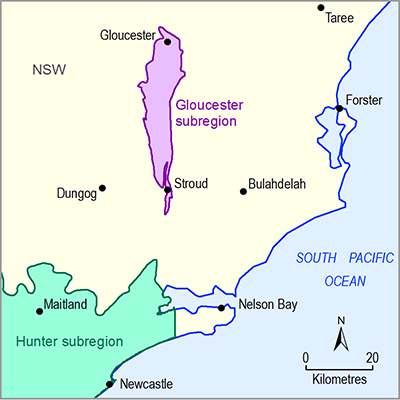- Home
- Assessments
- Bioregional Assessment Program
- Gloucester subregion
- 1.1 Context statement for the Gloucester subregion
- 1.1.7 Ecology
- 1.1.7.2 Terrestrial species and communities
The Gloucester subregion lies almost entirely within the IBRA Karuah-Manning subregion within the IBRA NSW North Coast (NNC) bioregion and also within the North Coast botanical region described by Harden (1990). The vegetation of the IBRA NNC is briefly described as: humid; hills, coastal plains and sand dunes; Eucalyptus – Lophostemon confertus tall open forests, Eucalyptus open forests and woodlands, subtropical rainforest (often with Araucaria cunninghamii and Melaleuca quinquenervia), wetlands and heaths (Environment Australia, 2000).
The IBRA Karuah-Manning subregion is located in the south of the IBRA NNC bioregion and is largely comprised of coastal barrier sands, estuarine plains and alluvial deposits (DECCW, 2009). Over half of this IBRA subregion has been cleared but it still supports significant wetlands, coastal sand heaths and woodlands from Fullerton Cove north to Port Stephens. The following description of the vegetation in the IBRA Karuah-Manning subregion is based on NSW National Parks and Wildlife Service (NPWS, 2003). In the south of the IBRA NNC bioregion on the Barrington Plateau, cool temperate species are common and the fertile basaltic soils support rainforest including Antarctic beech (Nothofagus moorei) which forms a two tiered forest structure. Here it occurs as the only overstorey species with a fern understorey. Rainforests are also sometimes found inhabiting protected pockets where plant nutrients have accumulated in litter. In contrast, eucalypt vegetation communities mainly occur on granitic soils; dominant species include blackbutt (Eucalyptus pilularis), Sydney blue gum (Eucalyptus saligna), spotted gum (Eucalyptus maculata), grey gum (Eucalyptus punctata), forest red gum (Eucalyptus tereticornis), red bloodwood (Corymbia gummifera), brush box (Tristania conferta) and white mahogany (Eucalyptus acmenoides).
In the coastal dunes, coastal tea tree (Leptospermum laevigatum) and coastal wattle (Acacia longifolia) occur near the beach, with some areas of beach she-oak (Casuarina equisetifolia), snappy gum (Eucalyptus racemosa), blackbutt, dwarf red bloodwood and bastard mahogany (Eucalyptus umbra). Banksia and bangalow palms are found in the dunes and heath and paperbark swamps occur behind the dunes and near the lagoons. Where sufficient nutrients have accumulated, rare patches of rainforest species may also be found.
Almost none of the Gloucester subregion lies within conservation reserves compared to 16% of the IBRA Karuah-Manning subregion. The majority of the Gloucester subregion is cleared (see Section 1.1.2). The major land uses are grazing on modified pastures, intensive urban use or other commercial uses. Much of the remnant vegetation in the Gloucester subregion lies within areas classified as ‘Other minimal use’ or ‘Water’, which are mainly distributed along the margins of the subregion, on or adjacent to hill slopes, or along watercourses. A significant nature conservation area lies south of the subregion along the eastern edge of the Karuah National Park. Much of the vegetation is eucalypt forest (see Section 1.1.2), with open eucalypt forest and grassy understorey being the single most common natural vegetation type within the subregion (Table 9). Much of the riparian zone has been cleared from the banks of the Gloucester River north of Gloucester along the Manning River. In contrast, the banks of the Karuah River from Stroud to Karuah are well-vegetated. The section of Karuah National Park within the subregion contains eucalypt forest with a broadleaf/fern or woody understorey and substantial areas of mangroves.
Table 9 Vegetation of the Gloucester subregion
Comparative areas of vegetation within the Gloucester subregion and the IBRA* Karuah-Manning subregion of the IBRA NSW North Coast bioregion.
* Interim Biogeographic Regionalisation of Australia
Sixteen threatened ecological communities are listed under the TSC Act. One is listed as critically endangered and four are endangered (Table 10), and may be present within the IBRA Karuah-Manning subregion. This includes twelve vegetation and two animal threatened ecological communities. Five of the vegetation and one of the animal threatened ecological communities are also listed under the EPBC Act, including three listed as critically endangered (Table 10).
Table 10 Conservation status of threatened ecological communities found in the IBRA* Karuah-Manning subregion
As listed under NSW’s Threatened Species Conservation Act 1995 (the TSC Act) or the Commonwealth’s Environment Protection and Biodiversity Conservation Act 1999 (the EPBC Act).
* Interim Biogeographic Regionalisation of Australia.
Source data: http://www.environment.nsw.gov.au/threatenedSpeciesApp/AreaHabitatSearch.aspx?cmaname=Hunter-Central+Rivers.
There are 56 threatened fauna and twelve threatened flora species listed under the TCS Act that may occur within the Gloucester subregion (Table 11). This includes 18 threatened fauna and eight threatened flora species that are listed as vulnerable or endangered under the EPBC Act.
Table 11 Conservation status of threatened flora and fauna species recorded in the Gloucester bioregion
As listed under NSW’s Threatened Species Conservation Act 1995 (the TSC Act) or the Commonwealth’s Environment Protection and Biodiversity Conservation Act 1999 (the EPBC Act) that have been recorded in or that may occur in the Gloucester subregion.
Source data: http://www.bionet.nsw.gov.au/.

